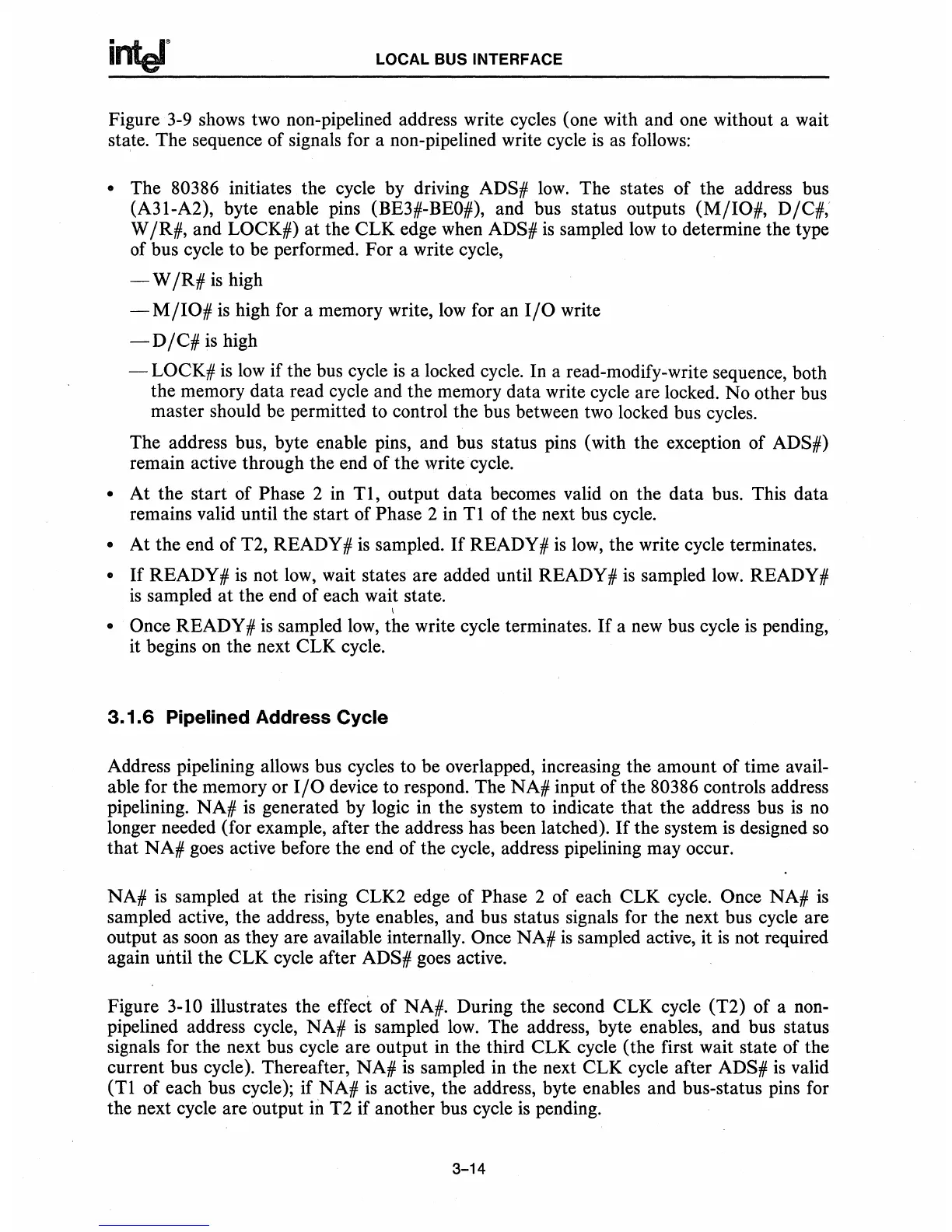LOCAL BUS INTERFACE
Figure 3-9 shows two non-pipelined address write cycles (one with and one without a wait
st~te.
The sequence of signals for a non-pipelined write cycle
is
as
follows:
• The 80386 initiates the cycle by driving ADS#
low.
The states of the address bus
(A31-A2), byte enable pins (BE3#-BEO#), and bus status outputs
(M/IO#,
D/C#,
W
/R#,
and LOCK#)
at
the CLK edge when ADS#
is
sampled
low
to determine the type
of bus cycle to be performed. For a write cycle,
- W
/R#
is
high
-
M/IO#
is
high for a memory write,
low
for an
I/O
write
-D/C#
is
high
-
LOCK#
is
low
if the bus cycle
is
a locked cycle. In a read-modify-write sequence, both
the memory data read cycle and the memory data write cycle are locked. No other bus
master should be permitted to control the bus between two locked bus cycles.
The address bus, byte enable pins, and bus status pins (with the exception of ADS#)
remain active through the end of the write cycle.
•
At
the start of Phase 2 in
Tl,
output data becomes valid
on
the data bus. This data
remains valid until the start of
Phase 2 in
Tl
of the next bus cycle.
•
At
the end of T2, READY # is sampled.
If
READY #
is
low,
the write cycle terminates.
•
If
READY# is not
low,
wait states are added until READY#
is
sampled
low.
READY#
is
sampled
at
the end of each wait state.
,
• Once READY #
is
sampled
low,
the write cycle terminates.
If
a
new
bus cycle
is
pending,
it begins on the next CLK cycle.
3.1.6
Pipelined Address Cycle
Address pipelining allows bus cycles to be overlapped, increasing the amount of time avail-
able for the memory or
I/O
device to respond. The NA# input of the 80386 controls address
pipelining. NA# is generated by logic in the system to indicate that the address bus
is
no
longer needed (for example, after the address has been latched).
If
the system is designed
so
that
NA#
goes active before the end of the cycle, address pipelining may occur.
NA#
is
sampled
at
the rising CLK2 edge of Phase 2 of each CLK cycle. Once NA#
is
sampled active, the address, byte enables, and bus status signals for the next bus cycle are
output
as
soon
as they are available internally. Once NA#
is
sampled active, it
is
not required
again
until the CLK cycle after ADS# goes active.
Figure 3-10 illustrates the effect of NA#. During the second CLK cycle (T2) of a non-
pipelined address cycle, NA# is sampled
low.
The address, byte enables, and bus status
signals for the next bus cycle are output in the third CLK cycle (the first wait state of the
current bus cycle). Thereafter,
NA#
is
sampled in the next CLK cycle after ADS#
is
valid
(Tl
of each bus cycle); if NA#
is
active, the address, byte enables and bus-status pins for
the next cycle are output
in T2 if another bus cycle
is
pending.
3-14

